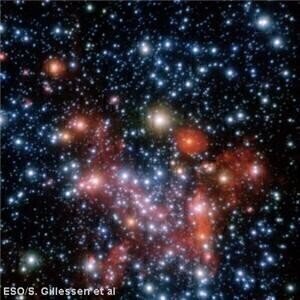News & Views
Star Collision provides insight into Origin of Heavy Elements
Jun 21 2022
Researchers from Queen’s university Belfast, who have been analysing the results of a neutron star collision have succeeded in identifying some of the heavy elements that were created following impact.
In 2017, Professor Stephen Smartt from the University led one of the international teams that produced a historic and ground-breaking discovery, proving that a burst of gravitational waves came from the collision of two neutron stars. Extensive analysis of the debri, led by PhD student James Gillanders and supervised by Professor Stephen Smartt and Dr Stuart Sim, revealed that these elements included strontium and zirconium, as well as the very heavy lanthanide group of elements, such as cerium and neodymium.
Collaborating with researchers from the Free University of Brussels and the GSI Helmholtz Center for heavy ion research in Darmstadt, they compiled as comprehensive an atomic data set as possible, enabling them to explore the production of the elements heavier than iron, since the origin of these elements remains somewhat a mystery in modern astrophysics.
The team calculated computer models of how light interacts with these elements on the Northern Ireland High Performance Computing Centre (HPC), hosted at Queen’s.
James Gillanders said “By modelling the observations of this explosion, I have identified the presence of some of the heavy elements in the Universe, through signatures imprinted by their atomic lines. This research helps to show that these exotic mergers are responsible for producing many of the heavy elements that we see around us in the Universe today. We’d like to find at least a few more of these objects to give us a reasonable sample size, and then model them in a similar way, using this excellent computing facility at Queen’s.”
Professor Stephen Smartt commented: “The event of a neutron star merging with another is relatively rare but the information we have been able to gather since our discovery has been invaluable – it has helped to solve some of the big questions around the origin of heavy elements in the Universe.
“Our collaboration with expert nuclear physicists in Belgium and Germany, combined with Queens’ computing facility, means we can combine extensive theoretical data with the extensive observations we took in 2017. It is detailed work that takes time, but this discovery has paved the way for 2023. That is when the gravitational wave detectors come back online for another year of observing. Our team at Queen’s will continue their quest to investigate the final life stages of these incredibly dense stars and the mysteries of their origin."
More information online
Digital Edition
Lab Asia 31.2 April 2024
April 2024
In This Edition Chromatography Articles - Approaches to troubleshooting an SPE method for the analysis of oligonucleotides (pt i) - High-precision liquid flow processes demand full fluidic c...
View all digital editions
Events
Apr 28 2024 Montreal, Quebec, Canada
May 05 2024 Seville, Spain
InformEx Zone at CPhl North America
May 07 2024 Pennsylvania, PA, USA
May 14 2024 Oklahoma City, OK, USA
May 15 2024 Birmingham, UK



















